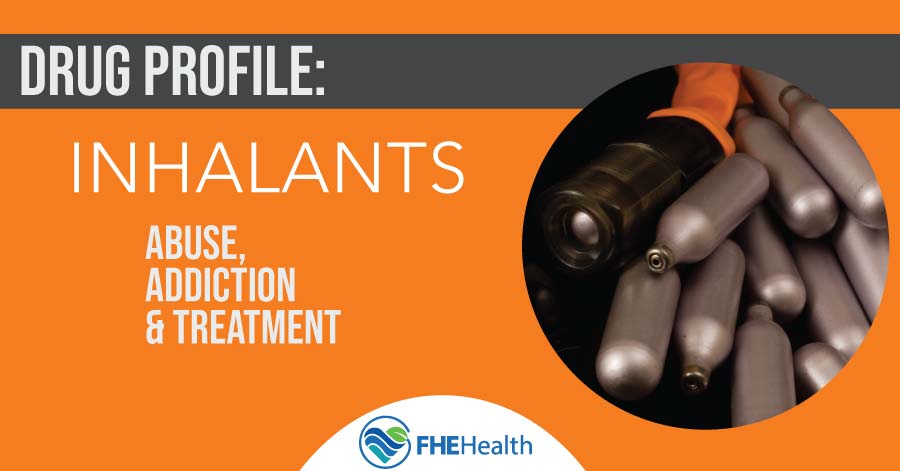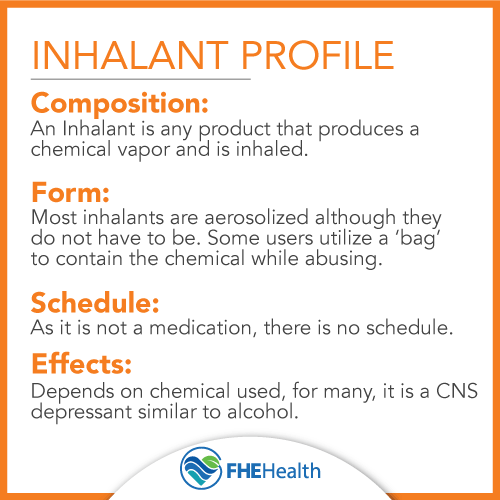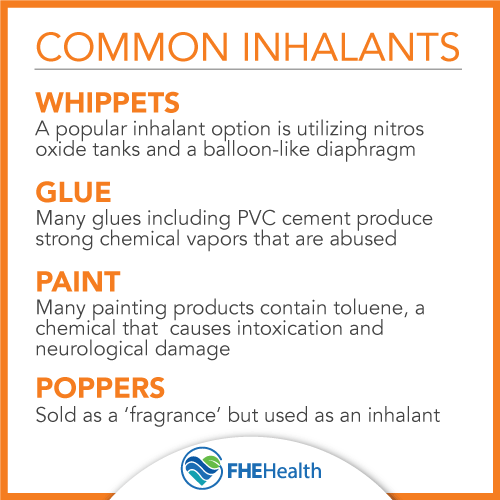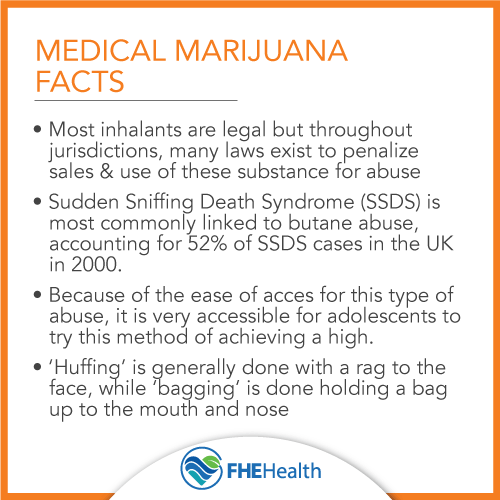
|
|
Common household items have a long history of being used by people for a purpose other than what they were intended for: Things like spray paint, glue, contact cement, nail polish and paint thinner are being inhaled through the nose or mouth for the quick and inexpensive “high” that they give. Even medicinal gases and compounds, such as nitrous oxide and chloroform, can be abused when inhaled in greater doses than recommended and for purposes not set out by the maker. Using these substances or types of inhalants for intoxication rather than for the uses they were created for can have extreme health implications and can easily lead to addiction or sudden sniffing death.
What Are Inhalants?
 The term “inhalant” refers to a large class of vaporized or pressurized household, medical or industrial chemicals that are inhaled to achieve intoxication. These chemicals include, but aren’t limited to, nitrous oxide, butane, certain types of glue, toluene, benzene and amyl nitrate. Some of these substances are inhaled at room temperature; others are heated and then inhaled or sniffed. Inhalants are also sometimes inhaled through a saturated rag.
The term “inhalant” refers to a large class of vaporized or pressurized household, medical or industrial chemicals that are inhaled to achieve intoxication. These chemicals include, but aren’t limited to, nitrous oxide, butane, certain types of glue, toluene, benzene and amyl nitrate. Some of these substances are inhaled at room temperature; others are heated and then inhaled or sniffed. Inhalants are also sometimes inhaled through a saturated rag.
Marijuana and tobacco, while inhaled, are not considered “inhalants” when talking about substance abuse and addiction. The DEA draws this distinction with chemicals that are rarely if ever used in any other route except inhaled. More than 22 million Americans, ages 12 and older, report having used inhalants to “get high” at least once in their lives. Approximately 750,000 Americans try inhalants for the first time each year. Young people are often drawn to this drug class because of its affordability and easy access when compared to other recreational drugs.
Other commonly used names for inhalants include “poppers” (amyl nitrate), “highballs,” whippits” (Nitros Oxide), “whiteout” (isobutyl nitrate) and “aimies” (amyl nitrate). The act of getting high on inhalants is often called “huffing,” “sniffing” or “bagging,” depending on the method used.
While most inhalants are legal, several states have enacted legislation to restrict access to them by minors. Thirty-eight U.S. states have laws against selling inhalants to minors or using inhalants for intoxication.
What Inhalants Do to the Human Body?

Inhalants as a class are among the least studied recreational drugs in use today. Each substance reacts somewhat differently when introduced to the human body. Because they are inhaled, these substances produce an almost immediate “high,” which is generally short-lived. The short-term nature of the high leads users to repeatedly use these substances in an effort to extend their state of intoxication.
Some of the most commonly abused inhalants are Central Nervous System depressants which will create effects similar to alcohol or opioid abuse. Other inhalants are stimulants and will produce results closer to that of cocaine use.
Research has shown that this level of use can lead to breathing difficulties, limb spasms, heart attacks and loss of consciousness. According to the National Institute on Drug Abuse, as many as 200 people per year die as a result of this combination of systems, often referred to as “sniffing death”. Long-term use of inhalants has also been associated with brain damage and memory loss as well as neurological diseases such as multiple sclerosis.
Chronic use of inhalants can also harm organs, such as the kidneys and liver, which work to rid the body of toxic substances. Some of this damage may be partially reversible once the person ceases his or her drug use. However, much of the damage can end up being permanent.
Traces of inhalants and their metabolites can be detected in a person’s system for just a few hours after the last use. It may take chronic users somewhat longer for the drug to be undetectable in their system.
What Does Addiction to Inhalants Look Like?
 Unlike alcohol use or even marijuana use, there is no acceptable level of inhalant use. Any amount of inhalant use should be considered dangerous to a person’s health and a problem. However, treatment is indicated if this use interferes with a person’s work, family life and other responsibilities.
Unlike alcohol use or even marijuana use, there is no acceptable level of inhalant use. Any amount of inhalant use should be considered dangerous to a person’s health and a problem. However, treatment is indicated if this use interferes with a person’s work, family life and other responsibilities.
Although this is a broad category with many variables, it is possible to create a chemical dependency on certain chemicals being inhaled. Just as it is possible to form an addiction from inhaling other addictive substances such as nicotine. Certain chemicals create physical dependency more readily than others. It is possible that an inhalant addiction is a largely habitual and compulsory function of the user chasing a euphoric high.
If there is a chemical dependency, it will create a unique withdrawal process when usage is ceased. However as with most addictions, sudden cessation will bring about a period of withdrawal symptoms caused by the psychological stress and physical absence of the chemical. The signs of active inhalant abuse, regardless of specific drug type, include: loss of appetite and in turn weight; disorientation and confusion; dilated pupils (when high); shakiness; and extreme mood swings.
Add to these the classic behavioral signs of any drug addiction that include withdrawal from family and friends, lack of money despite an adequate income, borrowing and stealing money, having friends that aren’t introduced to family and old friends, getting phone calls and visitors at all hours of the day and night, and getting caught in fibs or outright lies.
Dangers of inhalant abuse include depression, isolation and loss of job or family members. Inhalants are often considered to be a stepping stone to other addictive drugs, such as cocaine, methamphetamine and heroin. Inhalant use by pregnant women has been shown to affect the cognitive and learning abilities of their babies as well as the child’s birth weight.
What Are Treatment Options for Addiction to Inhalants?
The good news for anyone hooked on inhalants is that you can find freedom from addiction. Many rehab facilities offer residential treatment programs that can help you recover your health in a nurturing, therapeutic environment, far away from the stresses and people that enabled your addiction.
Residential treatment begins with a period of medically supervised detox, followed by intensive group and individual therapies, such as cognitive-behavioral therapy (CBT), that address the roots of your addiction. CBT helps patients develop greater emotional self-awareness and change destructive behavioral responses to various emotions, such as anger and sadness. (Often, substance abuse is one of these “destructive behavioral responses” that needs to be replaced with healthier coping mechanisms.)
After residential treatment, many patients transition into aftercare and/or out-patient programs that help them build on what they learned in rehab, strengthening their long-term resilience to addiction.
The Next Step
Please don’t ever hesitate to reach out for help if you or someone you love is struggling with addiction to inhalants! Contact FHE Health today. Our experienced and caring team of recovery counselors is waiting to take your call anytime of day or night. Let today be the first day of your new life in recovery!






